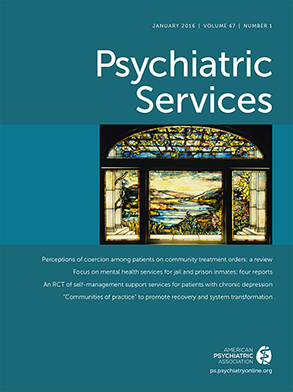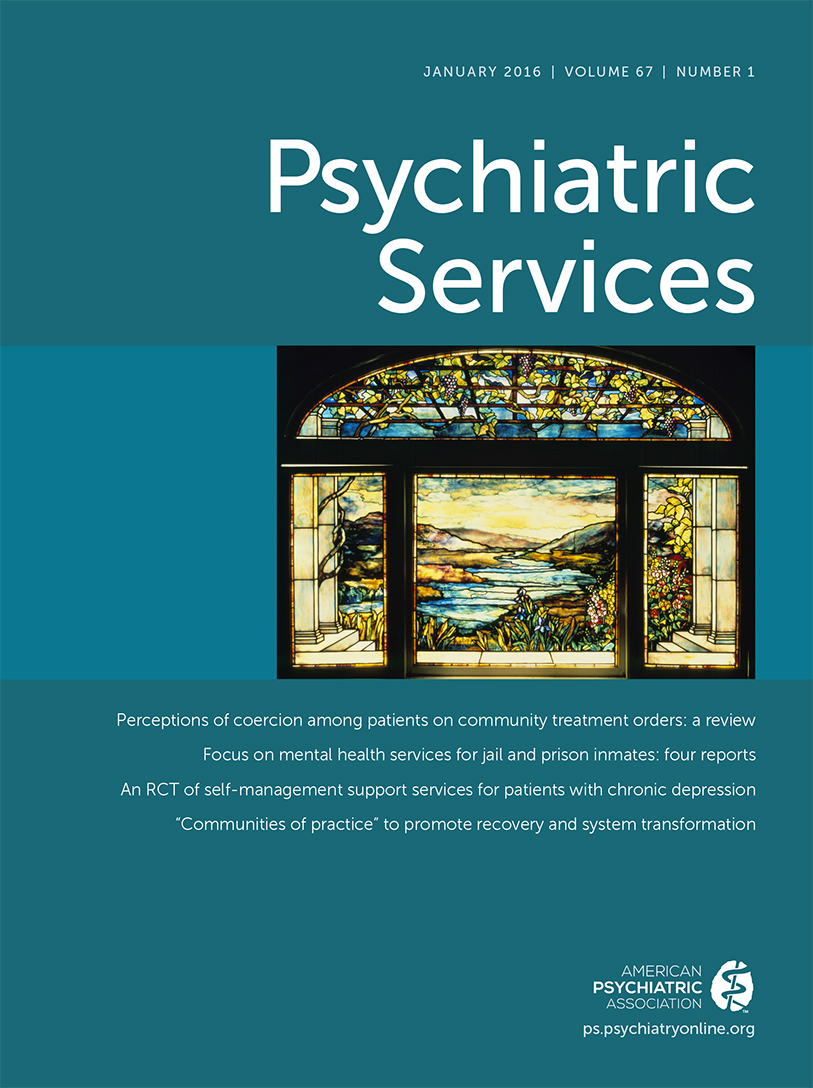Burnout is an occupational phenomenon, typically characterized by the gradual “wearing away” of an individual’s physical and mental well-being, resulting in a variety of adverse job-related outcomes. These may include a growing sense of disillusionment in one’s work, decreased effort on job-related tasks, and often, a decline in job performance (
1). It has been suggested that occupations that require close interpersonal relationships, such as mental health services, are more likely than jobs not related to human services to result in burnout (
2).
The consequences associated with burnout range from impaired health to diminished emotional and mental well-being (
2). For example, one study found that burnout was associated with depression, anxiety, sleep problems, impaired memory, somatic pain, and increased alcohol consumption (
3). In addition to these individual effects, burnout can also lead to staff turnover and impaired professional performance (
2).
Studies on the prevalence of burnout of mental health service providers indicate that levels of emotional exhaustion (a key component of burnout) vary widely among providers, ranging from 21% to 67% (
2,
4,
5). These samples, however, primarily report data from providers who serve nonmilitary clients. Military mental health service providers (including active-duty providers and civilians working in military facilities) serve patient populations who have often experienced wartime trauma and deployment-related stressors. In their review of clinical military psychologists, Linnerooth and colleagues (
6) suggested that these factors may put military mental health service providers at increased risk of secondary traumatic stress, compassion fatigue, and professional burnout.
This study aimed to address this gap in knowledge about burnout among military mental health service providers by examining the prevalence of professional burnout and job satisfaction of Army mental health service providers. In addition, we examined clinician factors associated with professional burnout among Army mental health service providers (for the purposes of this report the terms “burnout” and “professional burnout” will be used interchangeably).
Methods
Data were collected through the Walter Reed Army Institute of Research (WRAIR) Behavioral Health and Treatment Study (with approval from the WRAIR institutional review board), between May and September of 2010. Recruitment e-mails were sent to 2,310 active-duty, Department of Defense (DoD) civilian, or contract-based Army mental health care service providers; this sample represented a majority of practicing Army mental health service providers. Initial nonresponders were contacted via e-mail up to three additional times. Full recruitment and selection methods are described elsewhere (
7). With the exclusion of undeliverable e-mails (N=154), the response rate for this sample was 28% (N=595), of which 488 providers completed the survey items related to burnout. The sample was predominantly female (58%) and over 40 years old (67%). The most common self-identified occupation was social worker (46%); there were no significant differences between responders and nonresponders with respect to occupation (
7). Data were weighted to the proportions of specialties to attenuate the nonresponse bias by specialty.
Providers were asked to rate several job-related domains on a 5-point ordinal scale. Burnout was assessed with the item “Please rate the following: Your level of professional burnout.” Response options were very low, low, medium, high, and very high. Participants were also asked to rate their overall job satisfaction, their satisfaction with their salary and compensation, and other practice-related questions. Burnout status was categorized into elevated levels (responses of high and very high) and nonelevated levels (responses of very low, low, and medium). Responses about job satisfaction and satisfaction with salary were collapsed into three levels: low (very low and low), medium (medium), and high (high and very high). In addition to the main outcomes, participants were asked basic practice characteristics, such as caseload and hours worked per week, and to rate their confidence treating common psychiatric diagnoses (including posttraumatic stress disorder [PTSD], depression, anxiety disorders, substance use disorders, traumatic brain injury or concussion, and suicidal ideation) and to indicate the number of hours of their formal psychotherapy training, the number of years they had been practicing, the number of years they had been treating military patients, and whether they planned to leave their current job within the next two years.
Contingency tables were used to compare clinician characteristics between those reporting and not reporting burnout. [These tables can be found in an online supplement to this report.] Logistic regression models were used to estimate adjusted odds ratios (AORs) and 95% confidence intervals for burnout and several factors, including job characteristics, sex, and occupational specialty. The data were analyzed with the use of weights that reflect the composition by specialty of the target population. All analyses were conducted with Stata version 10 survey procedures.
Results
Approximately 21% (N=103) of respondents reported elevated levels of job-related burnout. The sociodemographic composition of the sample with elevated burnout did not significantly differ from the overall sample by sex, age, or specialty. [Additional detail on breakdown of responses is available in the online supplement.] High job satisfaction was reported by 67% of mental health service providers, with only 10% of the total sample endorsing low levels; however, among those reporting burnout, a higher proportion endorsed low job satisfaction (25%).
Logistic regression models identified several variables associated with elevated burnout. Low job satisfaction was the largest predictor of elevated burnout (AOR=4.55). This is unsurprising given the overlapping nature of the two constructs. Other factors with significant associations were, in order of effect size, working over 44 hours per week, having treated military populations for ten years or more, being female, and having a caseload of 20 or more patients per week (
Table 1). Overall means±SE for clinician caseload and hours worked in a typical week were 19.9±.84 and 42.2±.54, respectively. Compensation satisfaction and intent to leave the workplace within two years had a simple bivariate association with burnout (p<.05; data not shown) but were no longer significant when entered in the final model. Job specialization, confidence in psychotherapy treatment, and number of years treating mental health problems were not found to significantly differ between those reporting and not reporting burnout.
Discussion
The prevalence of self-reported burnout observed in this sample of military mental health service providers was slightly lower than rates reported in similar published findings. It is possible that the lower prevalence of burnout observed in this study can be explained by the use of a one-item screen rather than a full questionnaire (such as the Maslach Burnout Inventory [MBI]). In a study of social workers by Siebert (
5), burnout was jointly assessed by the MBI as well as a single-item question; in that sample, the MBI resulted in a higher prevalence of burnout than the one-item screen (36% versus 18%). This limitation and the low response rate in this study suggest that the findings of this study should be interpreted judiciously. Direct comparison of our findings with findings of other studies is hindered by the hegemony of the MBI (
8) as a burnout assessment tool. Many studies using the MBI report not the percentage of individuals with elevated levels of burnout but the mean scores on individual MBI subscales. One of the subscales, emotional exhaustion, has been suggested to be the most representative of the three MBI subscales (
1), and several studies identified individuals who scored in the high range of the emotional exhaustion scale (based on Maslach’s normative data) (
8). Two small studies of military and veteran behavioral health personnel, by Ballenger-Browning and colleagues (
9) and Saban and colleagues (
10), reported emotional exhaustion ratings of “high” for 28% and 24% of their samples, respectively. Two civilian-based studies, one by Ackerley and colleagues (
4) and the other by Rupert and Kent (
11), also categorized emotional exhaustion into ordinal levels and found that 34% and 40% of their samples, respectively, scored in the high range for emotional exhaustion. Why the prevalence of emotional exhaustion has been higher in civilian samples than in military samples is unknown, although this finding has been reported in direct-comparison studies (
12). One possibility is that there is potential for categorical overlap in clinician-reported data, because many clinicians provide services to diverse populations and perhaps nonspecific civilian samples include clinicians who treat veterans.
As mentioned previously, a notable limitation of this study was a low response rate (28%), although this is comparable to response rates on other Web-based surveys (
13). Efforts were made to reduce the effect of this limitation by approaching every Army behavioral health clinician who could be identified by the Army Office of the Surgeon General rather than sampling from a roster of clinicians. Consequently, most of the Army’s behavioral health providers were invited to participate in our study, and our sample thus represents almost a quarter of the target population. The data were furthermore weighted by specialty and clinician caseload size to address nonresponse bias (
7).
Another limitation was the use of a single item to screen for burnout, although studies have found that a single-item burnout screen is a suitable alternative to common multiquestion scales, such as the MBI (
14).
Because of the potential negative outcomes associated with burnout, study results suggest that the DoD take precautionary steps to address job-related issues before they result in reduced effectiveness of military mental health service providers. It would be prudent to monitor clinicians’ caseloads and try to keep provider hours worked per week below 45, keeping in mind the statistical tipping point for burnout of 44–45 hours per week. In addition, clinic administrators and supervisors should also be aware that female clinicians and clinicians with greater lengths of service for treating military populations have increased likelihood of experiencing burnout. Management should also periodically assess provider attitudes (either formally or informally) and be proactive in providing additional resources and support. In addition, interventions to prevent and reduce burnout should be developed and validated and provided to military mental health service providers.
Conclusions
Burnout is a progressive condition, and efforts should be made to address problems before they reach levels that compromise job and organizational performance. Clinicians should be educated about burnout warning signs, as well as the dangers of leaving burnout untreated. Appropriate interventions should be facilitated for clinicians experiencing burnout or for those identified as being at risk of burnout. Increased use of mental health treatment represents an important step forward in significantly improving the overall health and well-being of military personnel (
15). This increase in demand for services also raises the potential for more widespread burnout issues for clinicians with increased workloads. If we hope to meet the military’s mounting mental health needs, it is essential that clinicians perform their duties in an effective and sustainable manner. Reducing burnout is an essential step toward that goal.

